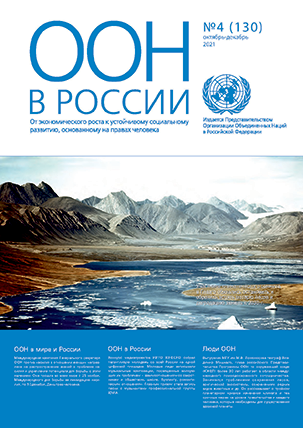As World Population Tops 7 Billion, People are Younger—and Older—Than Ever Before, States UNFPA Report
As World Population Tops 7 Billion, People are Younger—and Older—Than Ever Before, States UNFPA Report
Investments in healthcare and education are key, agency director says today in Moscow
MOSCOW, 26 October 2011—In five days, the world population is projected to reach 7 billion. How we respond now will determine whether we have a healthy, sustainable and prosperous future or one that is marked by inequalities, environmental decline and economic setbacks, according to The State of World Population 2011report, published today by UNFPA, the United Nations Population Fund.
The 2011 UNFPA State of World Population report was launched today in Moscow by Ms. Thea Fierens, UNFPA Regional Director for Eastern Europe and Central Asia. The report is also being launched simultaneously in more than 100 other cities worldwide.
Despite declines in global fertility, about 80 million people are added to the world each year and the global population is likely to reach 10 billion by the end of the century, the report shows. While Asia accounts for 60 per cent of world population, Africa’s population is likely to more than triple by 2100, when it is projected to reach 3.6 billion.
“Our record population size can be viewed in many ways as a success for humanity because it means that people are now benefitting from a higher quality of life”, said Ms. Thea Fierens at the report’s launch, speaking on TVC television and Radio Mayak. “It is not a story of exploding population growth anymore but a success for humanity because people are living longer and better. We are living 30 per cent longer. More of our children survive. We are now more urban”.
However, while population is on the rise in many parts of the world, the region of Eastern Europe and Central Asia is marked by population decline. Overall, the region has the lowest population growth rate in the world, at 0.3 per cent on average.
This demographic trend is a combination of multiple factors. High mortality and low fertility rates account for much of the natural population decline. In addition, many countries in the region are losing population due to significant emigration.
Charting a path now to development that promotes equality, rather than exacerbates or reinforces inequalities, is more important than ever. “The issue of population decline in the region requires a multi-pronged approach and trying to increase fertility rates alone will not suffice”, Ms. Fierens said during her radio interview. “Improving quality of life for our people and families is what really matters. Investing in young people and especially in young girls is the smartest thing we can do for our future”.
Of the world’s 7 billion, 1.8 billion are young people between the ages of 10 and 24. Young people hold the key to the future, with the potential to transform the global political landscape and to propel economies through their creativity and capacities for innovation. In Eastern Europe and Central Asia, the rapid decline in fertility since the end of 1980s has resulted in a rapid shrinkage of the younger generations. If countries grasp the opportunity to realize the great potential of young people, by investing in their health and education and by creating job opportunities for them, then this would yield enormous returns in economic growth and development for generations to come.
The milestone of 7 billion, set for 31 October, will be thus marked by achievements, setbacks and paradoxes. “Some of the trends are remarkable: Today, there are 893 million people over the age of 60 worldwide. By the middle of this century that number will rise to 2.4 billion”, says UNFPA Executive Director Dr. Babatunde Osotimehin in the foreword of the report, entitled People and Possibilities in a World of 7 Billion.
The region of Eastern Europe and Central Asia will be one of those most marked by the phenomenon of an ageing population, as the proportion of population above 60 in Eastern Europe is expected to rise to 42% by 2050. Today, in most countries of the region, the proportion of population above 60 is already 18%.
“We need solid policies in place, focused on the ageing population”, Ms. Fierens said on Radio Mayak. “Older people today are not the older people of 30 years ago. They live longer and they want to work longer. We can empower older women to participate fully in society and trigger progress in their families, communities and nations. This is key in the context of the ageing and high mortality trends of the region”.
The 7 billion milestone is a wake-up call. It’s a reminder that not everyone has benefited from the achievements of the past decades and that great disparities exist among and within countries. Disparities in rights and opportunities also exist between men and women, girls and boys.
“With planning and the right investments in people now—to empower them to make choices that are not only good for themselves, but also for our global commons—our world of 7 billion can have thriving sustainable cities, productive labour forces that fuel economies, and youth populations that contribute to the well-being of their societies,” says the report.
The State of World Population 2011 is mainly a report from the field, where demographers, policymakers, governments, civil society and individuals are grappling with population trends ranging from ageing to rapidly rising numbers of young people, from high population growth rates to shrinking populations, and from high rates of urbanization to rising international migration. The countries featured in this report are China, Egypt, Ethiopia, Finland, India, Mexico, Mozambique, Nigeria and the former Yugoslav Republic of Macedonia.
For more information, please contact:
Kristina Lezhanskaya: Phone: +7 985 923 0959; k.lezhanskaya@mail.ru
Gabriela Iancu: tel. +9 053 447 34925; iancu@unfpa.org
www.unfpa.org/swp/

